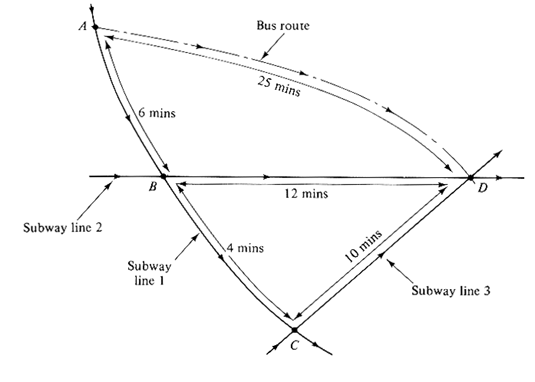|
6.3 Network model of commuter's choices In the case shown in
Figure P6.3, a commuter wishes to travel from his residence near station A
to his place of employment at D. The commuter's transportation choices are:
- Ride a bus from A to D; ride time is 25 minutes.
- Ride on subway line 1 to station B. change to subway line 2 and move
to D. Ride times for each leg are shown in Figure P6.3.
- Ride on subway line 1 to station C, change to subway line 3 and move
to D. Ride times for each leg are shown in Figure P6.3.

Headways between subways on all lines are exactly 10 minutes. Moreover,
the subway schedules are coordinated so that a line 2 train to D passes
through B exactly 4 minutes after a line 1 train has stopped at B. and
similarly, a line 3 train to D passes through C exactly 4 minutes after a
line 1 train has stopped at C. Assume that transfer times and stop time
are negligible.
Headways between buses at A are also constant and equal to 10 minutes.
| a. | Assuming that the commuter is aware
of the bus schedule and of the subway schedule and that he times his arrival
at A so that it coincides with the passage of whatever vehicle he chooses to
ride, prepare a network model for the situation shown in Figure P6.3. The
network model should be such that a shortest-path algorithm, such as
Algorithm 6.1, can be used to find the shortest path from A to D.
| | b. | Assume now that all headways in this
problem (for buses and subways) have negative exponential pdf's all with
means of 10 minutes. The commuter now arrives at a random time relative to
the passage of buses or subways from A. In addition, all subway lines are
operating independently of each other or of the bus. Prepare a network model
for this new situation such that one can determine, through a shortest-path
algorithm, the transportation mode and route that offers the shortest
expected travel time between A and D.
| | c. | What is the preferred route (and mode)
in each of parts (a) and (b) ? What is the shortest expected travel time in
each case?
|
|



